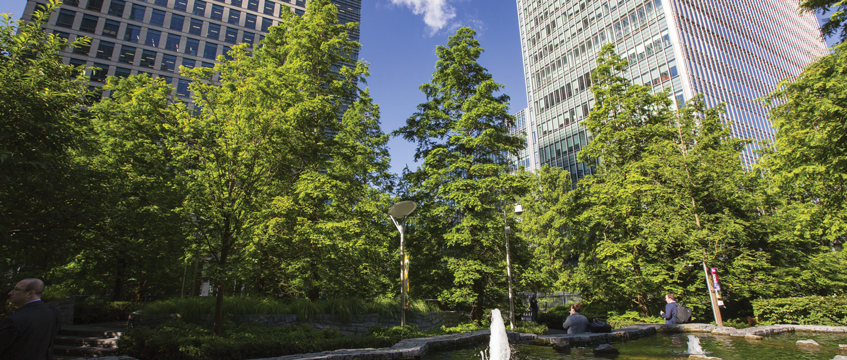Environmental sustainability is high on government agendas and investors and shareholders are putting pressure on businesses to behave responsibly. Corporate and social responsibility strategies across the real estate sector are placing obligations on businesses to identify ways to be “green”. Green loans hit the headlines in 2016 when Lloyds launched a £1bn commercial real estate green lending initiative to support these sustainability investment programmes and strategies.
In March 2018, the first “market standards” for green loans were published by recognised industry associations, including the Loan Market Association (LMA). In the UK, Lloyds, Barclays, HSBC and Bank of Scotland have all developed green loan frameworks and written green loans over the past 12 months with some of the real estate industry’s biggest names lining up to be among the first to draw down a green loan and demonstrate their green credentials in this way.
What are the principles set down by the LMA and how are they being interpreted and implemented by lenders in the real estate debt market?
What is a green loan?
A green loan, as defined by the LMA, is one where the loan proceeds must be used for “green projects”, meaning projects that provide clear environmental benefits and which can be assessed and, ideally, quantified, measured and reported on by the business owner. It is possible for an entire loan to be classed as green or for a specific tranche of a real estate or general corporate facility to be earmarked for an eligible green project. The latter arrangement means that there is flexibility for almost any corporate to take on a green loan.
The LMA principles set out a non-exhaustive list of projects that might be eligible for green funding. From a real estate perspective, examples might include:
- refurbishment or development of a new building with green credentials – this might involve obligations to secure an A-rated EPC, a BREEAM “very good” or “excellent” rating;
- achieving an agreed percentage use of renewable power or increasing renewably sourced energy by a specified percentage;
- installing smart meters, LED lighting or solar panels; and
- installation of cycle parking spaces.
In return, many lenders are offering margin discounts of up to 20bps on the cost of funding to those who deliver against their green covenants.
Eligibility criteria
To be eligible for a green loan, the business will need to be able to communicate to its lender its environmental sustainability objectives and the process it has used to determine that its project fits within the framework.
This may be results-based (in the case of EPC or BREEAM ratings) or linked to the borrower’s overarching corporate environmental or sustainability strategy. For some businesses, this is already part of the corporate DNA and data may be readily available. Where it is not, lenders are working with specialist sustainability consultants such as Sustainalytics and Trucosts to develop frameworks which help them and their customers identify projects that would be eligible for a loan and also to build out their eligibility and performance criteria.
The benefits
Financial: as noted above, from a purely financial perspective, some (but not all) of the lenders on the market offer a margin discount – thus reducing the overall cost of borrowing. This discount will last as long as the business remains in compliance with its green covenants.
Corporate and social responsibility: public opinion and governmental and regulatory bodies are increasingly aware of and focused on environmentally responsible behaviour. Further, and as noted above, investors and shareholders are increasingly holding businesses to account in this arena and green loans are a practical way for those businesses that have already made, or wish to develop, a sustainability strategy to demonstrate this commitment.
Good to know
The actual changes to finance documentation are generally relatively straightforward and can be dealt with either when a new facility is put in place or by way of an amendment of an existing facility.
In addition to satisfying the lender’s eligibility criteria, there are likely to be additional reporting requirements to evidence compliance with the metrics and goals that have been agreed. Depending on the nature of the facility and the relationship between the lender and the borrower, this may take the form of a self-certification exercise undertaken by borrower management or there may be a requirement for review and analysis by an external specialist consultant.
Either way, the continued availability of the funds and the facility will be dependent on an internal governance process through which the business can track the allocation of funds towards green projects and make and keep readily available up to date information on the projects to which the green loan proceeds have been allocated and their expected and actual impact.
At present, non-compliance with the green requirements of a green loan is not classified as an event of default under the facility. Instead, it would lead to the loan being declassified as a green loan and the loss of any margin discount.
What’s on the horizon?
In the green market alone, lenders are already introducing additional products which will make it easier for corporates to include green aims within their general revolving credit facilities, rather than green funding being available for named projects only.
In March, the LMA published its sustainability-linked loan principles. While similar in nature to the green loan principles, the stated aim here is wider, with sustainability-linked loans to have a broader aim of facilitating and supporting environmentally and socially sustainable economic activity and growth more generally.
It would seem that levels of sustainable lending are headed in one direction only.
Claire Illingworth is a partner in the real estate team at Irwin Mitchell








